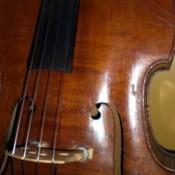 When purchasing an acoustic bass for your music program, there are
several things to keep in mind. With a little expert help and some
general know how, a solid choice can be made and a quality instrument
can be used by the students for many years.
When purchasing an acoustic bass for your music program, there are
several things to keep in mind. With a little expert help and some
general know how, a solid choice can be made and a quality instrument
can be used by the students for many years.
What does your program need:
Basses can range in price from $1,000 to $25,000 and more, so a good sense of what the program needs can help to get an idea of how much money to spend. Generally, a quality instrument can be purchased for $1,000 to $4,500. Acoustic basses do come in different sizes, from full size to ¼. A ¾ bass is the most common size available, it will produce a good tone and be playable for virtually all students. One of the biggest decisions to make will be plywood vs. carved. There are advantages to both, plywood basses are more durable but do not have the tonal quality that is present in a carved bass. Since students can be somewhat careless with school instruments, a carved bass might not be cost effective when repair work is factored in. Another option is a hybrid bass with plywood sides and back but a carved top. This gives a good mix of the two types of basses since they have most of the durability of plywood as well as some of the tonal benefits of a fully carved bass.
New is not always better:
Though it would seem that a new instrument is a good choice, for acoustic basses that is not always the case. With all of the cheap mass produced instruments coming out of factories at break-neck speeds, the overall quality of the instruments can be suspect. These new basses are usually cheaper than quality pre-owned basses but the cost of initial set-up can most often offset the savings. Acoustic instruments also have a “breaking in†phase where problems can occur so purchasing a used instrument will bypass the majority of these problems.
Making the choice:
When looking for a used instrument, a little more time and effort is required to make the choice. There are specialty bass shops in major cities such as the “Bass Cellar†in Cincinnati or David Gage's shop in New York. If there is not a specialty shop nearby, basses can be found at local music shops or on sites like Craigslist, though these are sometimes harder to come by. If a trip to a specialty store can be arranged, bring along a good idea of your price range as well as an experienced bass player to help make the choice.
Maintenance:
Keeping up with regular maintenance can help save money in the long run, as well as help students by having an instrument that is fun and easy to play. The most basic maintenance includes changing strings. How often depends on how much the instrument is being played on a regular basis. If the bass is being used by more than one student and a few ensembles, then changing strings once a year is in order. The choice of strings depends on what types of ensembles the bass is being used in. Specialized strings for Classical and Jazz can be used, but if there is a mixture of Jazz and Classical music, then hybrid strings would suit the instrument best. Also, keep in contact with students about any other problems that arise (open seams, cracks, nicks, etc...) the sooner these can be fixed the cheaper they will be.
